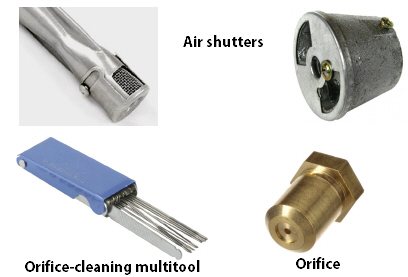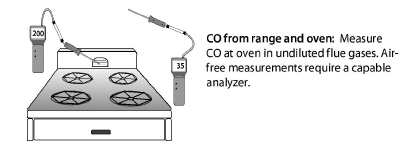
|
SWS Details: 2.0100.1 Global Worker Safety, 2.0201.2 Combustion Safety - Make-up Air, 6.6005.2 Kitchen Range, 6.6005.4 Kitchen Range Hood within Dwelling Unit (All Building Types) |
Gas ovens can release CO, natural gas, or propane into a kitchen. Oven burners are more likely to release CO compared to range-top burners so the oven burner is the most important burner to evaluate. Test the oven for combustion safety with these steps and take the recommended actions.
1. Test for gas leaks in the gas piping in and around the range and oven.
2. Prior to testing make sure oven is free of combustible items. Turn the oven on, and set it to bake on high temperature. Sample the CO level in exhaust gases at the oven vent and in the ambient air nearby after 10 minutes.
3. If the CO reading is over 200 ppm as measured or 800 ppm air-free, or if the ambient-air reading exceeds 35 ppm as measured during the test, discontinue testing.

4. Clean and tune the oven by removing aluminum foil, dirt, and corrosion around the burner. Many range and oven burners are equipped with adjustable needle-and-seat valves. Adjustment of the burner’s gas control to reduce CO must be performed by a qualified technician.
5. If the CO reading remains over 200 ppm as measured or 800 ppm air-free, consider replacing the oven and range if non-Weatherization funds are available.
6. Clean and adjust the stove burners if the burner flame has any discoloration, flame impingement, an irregular pattern, or if burners are visibly dirty, corroded, or bent. Many range and oven burners are equipped with adjustable needle-and-seat valves.
Caution: To protect yourself and the occupants, measure CO in the ambient air in the kitchen during these tests. If the ambient CO reading is 35 ppm or more, discontinue the testing.

Client Education about Ranges
Educate clients about the following safety practices in using their gas range.
✓ Never use a range burner or gas oven as a space heater.
✓ Open a window, and turn on the kitchen exhaust fan when using the range or oven.
✓ Buy and install a CO alarm, and discontinue use of the oven and range burners if the ambient CO level rises above 9 ppm as measured.
✓ Never install aluminum foil around a range burner or oven burner.
✓ Keep range burners and ovens clean to prevent dirt from interfering with combustion.
✓ Burners should display hard blue flames. Call a service company if you notice yellow flames, white flames, wavering flames, or noisy flames.
|
Performance Indicator |
Standard |
Test Location & Action Needed |
|---|---|---|
|
Burner CO |
Stove-top burner testing not permitted. |
|
|
Oven CO |
Level I 200 ppm or greater after 10 minutes
Level II 200 ppm or greater after servicing
|
Location: Insert probe in the vent sleeve before dilution air. Level I Action: If CO is 200 ppm or greater, install a carbon monoxide detector and call for servicing of the unit.
Level II Action - The unit must be serviced prior to weatherization work. If CO is 200 ppm or greater after servicing, provide exhaust ventilation with a capacity of 25 CFM continuous or 100 CFM intermittent |
|
Oven CO |
>800 air-free |
ANSI Standard |
CO Mitigation for Ovens
When you measure CO at 200 ppm as measured or 800 ppm air-free, at the oven vent while the oven is lit, consider these remedies.
• Make adjustments to reduce the CO level, or recommend a service call by a gas combustion specialist to adjust the fuel-air mixture of the burners.
• Install a CO alarm near the kitchen but at least 15 feet away from the range.
• Install an exhaust fan with a capacity of 100 cubic feet per minute (cfm) in the kitchen in a fan currently doesn’t exist there.
